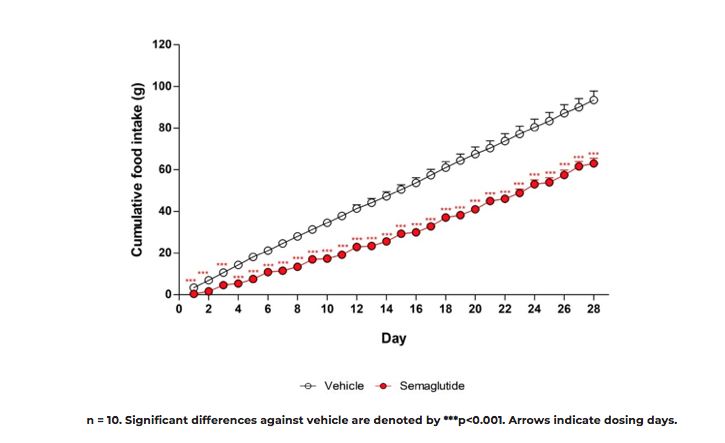Dietary-Induced obese (DIO) mice and rats
Dietary-induced obese (DIO) mice and rats are well-established animal models of obesity that offer proven predictive validity of clinically effective weight loss drugs.
Our DIO mouse model is ready to use, therefore enabling a quick start to your study and a seamless transition from DIO induction phase to testing of novel treatments.
Key features of our DIO mouse model are:
- Weight stable (allowing assessment of weight loss rather than inhibition of weight gain)
- Marked adiposity (30-40% fat)
- Moderate insulin resistance
- Ectopic lipid deposition and liver steatosis
- Elevated plasma lipids
Below is an example of a typical 4-week study using the DIO mouse model, which demonstrates efficacy of the clinically effective GLP-1 receptor agonist, semaglutide.
We have also developed and validated a DIO rat model using female Wistar rats allowed to develop obesity by ad libitum access to a simplified cafeteria diet, consisting of high-fat chow, ground chocolate and ground peanuts to mirror a typical calorie-dense Western diet. The DIO rat model has excellent predictive validity and is produced on demand, with a 16-week lead time.
Twice-weekly administration of semaglutide reduces body weight in the dietary-induced obese (DIO) mouse

Twice-weekly administration of semaglutide reduces cumulative daily food intake in the dietary-induced obese (DIO) mouse

Twice-weekly administration of semaglutide reduces total adiposity in the dietary-induced obese (DIO) mouse

Twice-weekly administration of semaglutide reduces liver lipid content in the dietary-induced obese (DIO) mouse

Twice-weekly administration of semaglutide improves glucose tolerance in the dietary-induced obese (DIO) mouse

Twice-weekly administration of semaglutide improves the plasma cholesterol profile in the dietary-induced obese (DIO) mouse

Studies in dietary-induced obese rats and mice are customised for each client and can include measurements of a range of different parameters.
Get in touch for more information or browse our models of metabolic disorders.
